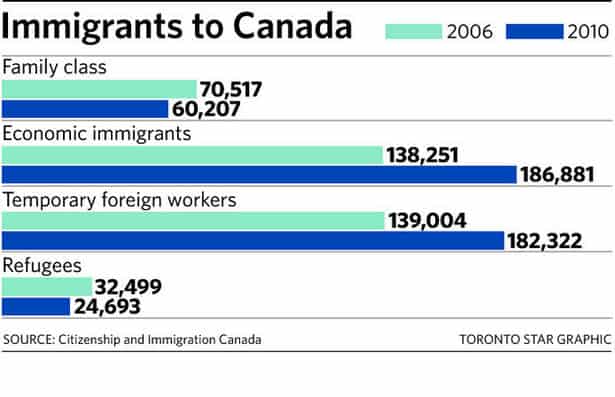
Canada’s immigration system has served as a model for countries around the world and was praised by U.S. President Donald Trump earlier this month. This system focuses more on immigrants who can contribute to Canada’s economy than to those with just family ties.
Nearly 63%of those granted legal permanent residence in Canada, which is the final step before becoming citizens, are admitted based of their economic skills, and only 24% admitted based on having family members living in the country.
But the U.S. system is reversed with 13% of green cards given to immigrants based on economic reasons and 63% given to those with family connections.
Canada was the first country to use a point system to grade economic immigrants — a 100-point scale that rewards immigrants with PhDs and extensive work experience in specialized fields.
Applicants are given a score on a 100-point scale, with points awarded in six categories:
- Language skills — the more fluent the applicant is in English and French, Canada’s two official languages, the more points he or she will get (28 points maximum)
- Education — maximum of 25 points (5 for a high school diploma, 19 for a two-year college degree, and 25 for a PhD)
- Work experience — the more skilled the job, and the more years spent doing it, the more points the applicant receives (15 points maximum)
- Age — the younger the applicant, the more points awarded (12 points maximum)
- Current job offer from a Canadian employer (10 points maximum)
- Adaptability — which includes things like family ties to Canadians or past visits to the country (10 points maximum)
The applicants who score 67 points or higher on the 100-point scale are eligible for immigration to Canada. Immediate relatives of Canadian citizens do not go through this process.
But Canada’s immigration system was not always like this. It wasn’t until the 1960s that the Canadian government set up a first-of-its-kind point system to grade immigrants on their skills and qualifications. It became increasingly popular in the 2000s and countries such as Japan, Denmark, and the United Kingdom adopted versions of it.
The formula for Canada’s immigration system has changed over the years since Canada has recently put more of an emphasis on immigrants who have standing job offers. Only admitting people with PhDs couldn’t be an economic cure-all for immigration to Canada. This is because many of those admitted couldn’t find jobs in their fields and were forced to do work that was far below their education levels.
Canada’s immigration system made a major revision in 2015, when it allowed Canadian provinces to sponsor immigrants based on labour shortages. The goal of this revision was to tie the system closer to local demands. Immigration to Canada has long been used as a way to drive its economic engine, and limits the relatives Canadian citizens can bring in.
It is now the United States’ time to adopt a new model. Trump’s has said that “switching away from this current system of lower-skilled immigration, and instead adopting a merit-based system, will have many benefits. It will save countless dollars, raise workers’ wages, and help struggling families — including immigrant families — enter the middle class.”
Now the question is just how much Trump wants to emulate Canada’s immigration system in doing so.





